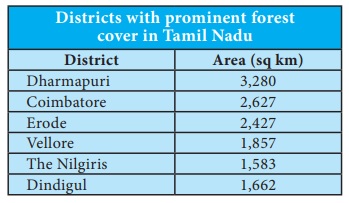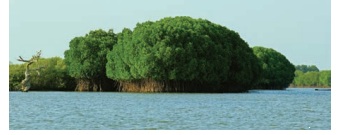Geography - Natural Vegetation and Forest Types of Tamil Nadu | 10th Social Science : Geography : Chapter 7 : Physical Geography of Tamil Nadu
Chapter: 10th Social Science : Geography : Chapter 7 : Physical Geography of Tamil Nadu
Natural Vegetation and Forest Types of Tamil Nadu
Natural Vegetation
Natural
vegetation refers to the forest cover. Landforms, nature of soil, temperature
and rainfall are the major factors that control the distribution of natural
vegetation. As per National Forest Policy, 1988, a minimum of one-third of the
total geographical area must be under forest cover. The total forest cover of
Tamil Nadu is far lower than this. According to the Tamil Nadu State of Forest
Report - 2017 assessment, the area under forest in the state is 26,281 sq.km,
which constitutes 20.21% of the total area. Tamil Nadu constitutes 2.99% of
India’s forest cover. The forest types in the state varies from wet evergreen
to scrub forests.
Forest Types
The
forest in the state is broadly divided into five types as follows
Tropical Evergreen Forest
This
forest type is found in the regions that receive heavy rainfall. It is a dense,
multi-layered forest. It is found in the upper slopes of Western Ghats of
Tirunelveli, Kanyakumari, the Nilgiris and Coimbatore districts. The major tree
species of this forest are cinnamon, Malabar ironwood, panasa, java plum/jamun,
jack, kindal, ayani and crape myrtle. The semi-evergreen type of forest in the
state is found over the regions of sub-tropical climate over the Eastern Ghats.
The prominent regions are Servarayan, Kollimalai and Pachaimalai. Species of
Indian mahogany, monkey teak, woolly cassia, jack and mango trees are common in
this region.
Montane Temperate Forest
It is
found in sheltered valleys of Anaimalai, Nilgiris and Palani hills over a 1000
metres altitude. They are known as ‘Sholas’.
The trees in this forest are evergreen and usually short. Nilgiri champa,
wights litsea and rose apple are the common trees found in this forest.
Tropical Deciduous Forest
This type
of forest lies in the margin of semi -evergreen and evergreen forests. The
trees in this forest shed their leaves during the dry season. The trees reach up
to a height of 30 metres. Some trees of this forest are silk cotton, kapok,
kadamba, dog teak, woman's tounge, axlewood and siris. Bamboos are also common
in this type of forests. Some trees of this forest are economically important.
Mangroves Forest
This type
of forest is found in the coastal areas, river deltas, tails of islands and
over sea faces where accretion is in progress. The vegetation is typically
evergreen, moderate in height and has leathery leaves. The vegetation of this
forest is adapted to survive in tidal mud and salt water. Asiatic mangrove,
white mangrove, wild jasmine/Indian pivot etc. are some of the notable trees of
this forest. Pichavaram, Vedaranyam, Muthupet, Chatram and Thoothukudi are the
places in Tamil Nadu where the mangrove forest is found to a considerable
extent.
Tropical Thorn Forest
Thorn
forest in Tamil Nadu is found where there is a little rainfall. These forests
are found from plains up to 400 meters altitude. The common trees of this
forest are rusty acacia, wheel, neem and palm. Shrubs are common vegetation in
this type of forest. This type of forest is found in the districts of
Dharmapuri, Ramanathapuram, Virudhunagar and some parts of interior districts.

Natural Vegetation Pichavaram mangrove forest is located near
Chidambaram, Cuddalore district. This is the second largest mangrove forest in
the world covering about 1,100 hectares (11 sq.km) of area. It is separated
from the Bay of Bengal by a sandbar. It consists of species like Avicennia and
Rhizophora.

Role of Mangroves in Coastal Zone Management.
Mangroves helps in the prevention of coastal erosion from waves
and storms. It also protects coral reefs and sea grass meadows from being
smothered in sediments.
Related Topics